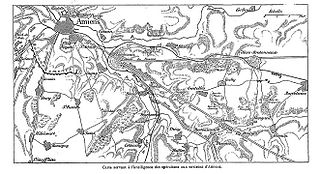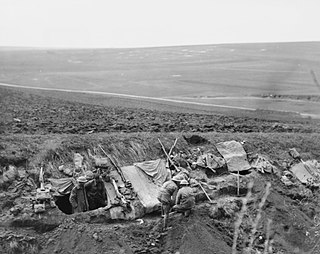
The II Corps was a corps-sized formation of the United States Army that was active in both World War I and World War II. It was originally formed and fought on the Western Front during World War I and was also the first American formation of any size to see combat in North Africa or Europe during World War II.

The Sturmpanzerwagen A7V was a heavy tank introduced by Germany in 1918 during World War I. One hundred chassis were ordered in early 1917, ten to be finished as fighting vehicles with armoured bodies, and the remainder as Überlandwagen cargo carriers. The number to be armoured was later increased to 20. They were used in action from March to October 1918, and were the only tanks produced by Germany in World War I to be used in combat, as well as being the first operational German Tank. It was developed as a response to British tanks. Although the A7V is generally considered to be better designed compared to its counterparts, it struggled to procure high production numbers due to its relative complexity and high cost.

The Battle of Hamel was a successful attack by Australian Army and US Army infantry, supported by British tanks, against German positions in and around the town of Le Hamel, in northern France, during World War I. The attack was planned and commanded by Lieutenant General John Monash, commander of the Australian Corps, and took place on 4 July 1918.

The Battle of Amiens, also known as the Third Battle of Picardy, was the opening phase of the Allied offensive which began on 8 August 1918, later known as the Hundred Days Offensive, that ultimately led to the end of the First World War. Allied forces advanced over 11 kilometres (7 mi) on the first day, one of the greatest advances of the war, with Gen Henry Rawlinson's British Fourth Army and Gen Marie Eugène Debeney's French First Army playing the decisive role. The battle is also notable for its effects on both sides' morale and the large number of surrendering German forces. This led Erich Ludendorff to later describe the first day of the battle as "the black day of the German Army". Amiens was one of the first major battles involving armoured warfare.

The 2nd Division of the Australian Army, also known as the 2nd (Australian) Division, commands all the Reserve brigades in Australia. These are the 4th in Victoria and Tasmania, the 5th in New South Wales, the 11th in Queensland, the 13th in Western Australia, and the 8th spread across the country. The division is also responsible for the security of Australia's northern borders through its Regional Force Surveillance Units.

The Battle of St Quentin Canal was a pivotal battle of World War I that began on 29 September 1918 and involved British, Australian and American forces operating as part of the British Fourth Army under the overall command of General Sir Henry Rawlinson. Further north, part of the British Third Army also supported the attack. South of the Fourth Army's 19 km (12 mi) front, the French First Army launched a coordinated attack on a 9.5 km (6 mi) front. The objective was to break through one of the most heavily defended stretches of the German Siegfriedstellung, which in this sector used the St Quentin Canal as part of its defences. The assault achieved its objectives, resulting in the first full breach of the Hindenburg Line, in the face of heavy German resistance. In concert with other attacks of the Grand Offensive along the length of the line, Allied success convinced the German high command that there was little hope of an ultimate German victory.

Mephisto is a World War I German tank, the only surviving example of an A7V. In April 1918, during a German attack at Villers-Bretonneux on the Western Front, it became stuck in a shell-hole and was abandoned by its crew. It was recovered by Allied troops about three months later and, after the war, taken to Australia as a trophy. Mephisto is housed at the Queensland Museum, in Brisbane, in the Anzac Legacy Gallery. It is not in running order.
The Battle of the Avre, part of the First Battle of Villers-Bretonneux, constituted the final German attack towards Amiens in World War I. It was the point at which the Germans got the closest to Amiens. It was fought between attacking German troops and defending Australian and British troops. The attack was an attempt to take Amiens, where other aspects of Operation Michael had failed. The Avre marked the beginning of the end for Ludendorf's German spring offensive.

The 5th Division was an infantry division of the Australian Army which served during the First and Second World Wars. The division was formed in February 1916 as part of the expansion of the Australian Imperial Force infantry brigades. In addition to the existing 8th Brigade were added the new 14th and 15th Brigades, which had been raised from the battalions of the 1st and 2nd Brigades respectively. From Egypt the division was sent to France and then Belgium, where they served in the trenches along the Western Front until the end of the war in November 1918. After the war ended, the division was demobilised in 1919.

The Battle of Amiens, also known as the Battle of Villers-Bretonneux, was fought on 27 November 1870 between French and Prussian forces during the Franco-Prussian War (1870–1871). It ended in a Prussian victory, forcing the French to retreat and allowing the Prussians to capture Amiens, France.

The First Battle of Villers-Bretonneux, took place during Operation Michael, part of the German spring offensive on the Western Front. The offensive began against the British Fifth Army and the Third Army on the Somme and pushed back the British and French reinforcements on the north side of the Somme. The capture of Villers-Bretonneux, close to Amiens, a strategically important road- and rail-junction, would have brought the Germans within artillery-range. In late March, Australian troops were brought south from Belgium as reinforcements to help shore up the line and in early April the Germans launched an attack to capture Villers-Bretonneux. After a determined defence by British and Australian troops, the attackers were close to success until a counter-attack by the 9th Australian Infantry Brigade and by British troops, late in the afternoon of 4 April, restored the line and halted the German advance on Amiens.

The Battle of Courtrai was one of a series of offensives in northern France and southern Belgium that took place in late September and October 1918.

Operation Michael was a major German military offensive during the First World War that began the German Spring Offensive on 21 March 1918. It was launched from the Hindenburg Line, in the vicinity of Saint-Quentin, France. Its goal was to break through the Allied (Entente) lines and advance in a north-westerly direction to seize the Channel Ports, which supplied the British Expeditionary Force (BEF), and to drive the BEF into the sea. Two days later General Erich Ludendorff, the chief of the German General Staff, adjusted his plan and pushed for an offensive due west, along the whole of the British front north of the River Somme. This was designed to first separate the French and British Armies before continuing with the original concept of pushing the BEF into the sea. The offensive ended at Villers-Bretonneux, to the east of the Allied communications centre at Amiens, where the Allies managed to halt the German advance; the German Army had suffered many casualties and was unable to maintain supplies to the advancing troops.

98th Brigade was an infantry formation of the British Army created to command 'Kitchener's Army' units during World War I. It served on the Western Front from 1916, seeing action on the Somme, at Arras and Ypres, during the German spring offensive and the final Allied Hundred Days Offensive.
The 173rd Brigade was a formation of the British Army's Territorial Force that was raised in 1915. It was assigned to the 58th Division and served on the Western Front during the First World War. Its number was used for a deception formation during the Second World War.

The Capture of Martinpuich took place on 15 September 1916. Martinpuich is situated 18 mi (29 km) south of Arras, near the junction of the D 929 and D 6 roads, opposite Courcelette, in the Pas-de-Calais, France. The village lies south of Le Sars, west of Flers and north-west of High Wood. In September 1914, during the Race to the Sea, the divisions of the German XIV Corps advanced on the north bank of the Somme westwards towards Albert and Amiens, passing through Martinpuich.

The Capture of Lesbœufs [25 September 1916] was a tactical incident in the Battle of the Somme. Lesbœufs was a village on the D 74 between Gueudecourt and Morval, about 30 miles (48 km) north-east of Amiens; Le Transloy lies to the north-west and Bapaume is to the north. French Territorials fought the II Bavarian Corps on the north bank of the Somme in late September 1914, after which the front line moved west past the village. Little military activity occurred round the village until the beginning of the Battle of the Somme, when German troops passed through the village in the first weeks of the battle. During the Battle of Flers–Courcelette (15–22 September), advances by the right flank corps of the British Fourth Army, brought the front line forward to the Gallwitz Riegel trenches west of Lesbœufs but exhaustion prevented the British from reaching their third objective, a line east of Morval, Lesbœufs and Gueudecourt.

The Capture of Eaucourt l'Abbaye was a tactical incident during the Battle of the Somme. Eaucourt is about 16 mi (26 km) south of Arras, at the junction of the D 929 and the D 10E roads. Eaucourt l'Abbaye (Eaucourt) is north-west of Martinpuich, south-east of Le Sars, south of the Butte de Warlencourt west of Gueudecourt and north-west of Flers. Eaucourt was a group of farm buildings in an enclosure built on the site of an Augustinian abbey, on a side road from Le Sars off the main Albert–Bapaume highway. Destremont Farm to the south-west of Le Sars and a derelict quarry south of Eaucourt had been fortified by the Germans.
The Staffordshire Brigade was a volunteer infantry brigade formation of the British Army from 1888 to 1936. It saw active service on the Western Front in World War I, including the attacks on the Hohenzollern Redoubt and the Gommecourt Salient, and the assault crossing of the St Quentin Canal, 'a most remarkable feat of arms'.

The First Battle of Morlancourt was fought over the period 28–30 March 1918, on the Western Front during World War I. The battle saw troops from the Australian 3rd Division advance to fill a gap in the Allied line that had formed north of the River Somme during the German spring offensive. This advance towards Morlancourt was checked by German troops short of the Australian's objective of the spur overlooking Morlancourt and the Australians were subsequently counter-attacked by elements of the German 18th Division. These attacks were repulsed with heavy casualties, as Allied forces blunted the German advance towards Amiens, which subsequently stabilised the Allied line north of the Somme. The fighting then largely moved south; however, in the months following, two further actions – albeit minor – were fought around Morlancourt as the Australians sought to consolidate their positions around the village prior to the start of the Allied Hundred Days Offensive.

















